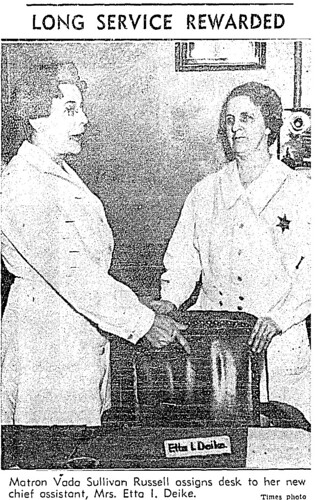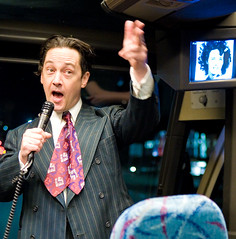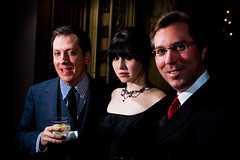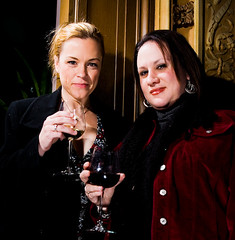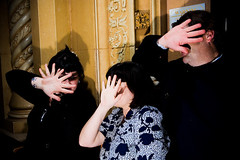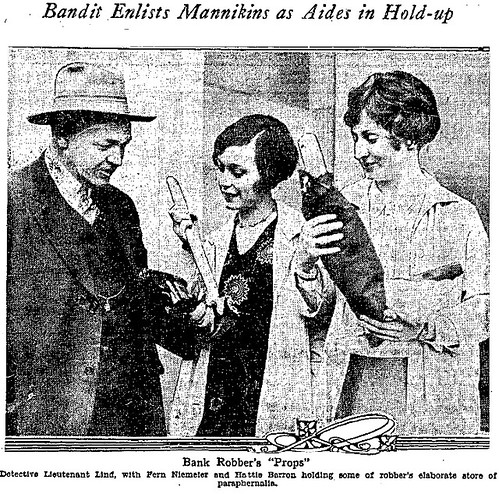 March 30, 1927
March 30, 1927
Los Angeles
Afterwards, when they examined the attic, they found evidence that he’d hidden for days up there, nourishing his evil plans with a diet of orange juice and liquor, quietly scheming during banking hours, constructing his army of robot helpers after everyone went home.
Ah, yes, the robot helpers. These were artificial arms with toy guns in their “hands,” constructed with ropes and weights to smash through the ceiling of the Merchants’ National Trust and Savings Bank branch at 24th and Hoover just as the robber, clad in a hideous monkey mask, confronted his prey. Who would dare take on the robber while unseen, if strangely still, friends held the room at gunpoint?
And so it was that the robber, Luger in one hand and .22 in the other, held up Manager Philip Simon and five employees and relieved Simon of about $8400 in bills prepped for the day’s banking. He was hard to ID beneath the gruesome cheesecloth monkey mask covering the upper portion of his face, but his victims noted that he was a small man, with a distinctive jaw and thick foreign accent with which he called some of them by name, apparently having spied on the workers during his time above.
This was the second peculiar robbery to befall Merchants’ National in less than a week; on March 25, two cliche Old West cowboys armed with .45s ambled into the branch at Jefferson and San Pedro and courteously relieved the cash drawers of about $2000 after suggesting customers and staff find comfy spots on the floor.
As for our mad attic genius, he made a clean getaway, and his identity remained mysterious until November 2, 1929, when officers stopped a man named Pete Marzec (aka Pete Nanzec), 33, while he was walking near Seventeenth and Main. They asked if they could open his suitcase, and Marzec obliged, but around the time they pulled out his gun, rope ladder and mask collection, he made a dash for a nearby fence. He didn’t make it; a bullet through the gut sent him to Georgia Street Receiving Hospital in critical condition. Later, more burglary tools and guns were found in his room nearby at 1622 Santee Court.
Marzec recovered in time to be indicted on the 1927 job and an earlier bank robbery that netted $12,600. Despite the claims of a confederate that he was in Kansas City at the time of the crimes, Marzec was damned by the discovery of guns recognized by his victims, masks matching those worn in the robberies, and a notebook in which the dates and amounts taken from the banks was noted in Polish.
Marzec was a three time loser who as Michael Blevika had escaped from a New Mexico Prison in 1922, so his conviction came with a minimum sentence of 14 years in Folsom Prison. Superior Judge McComb, perhaps in recognition of the extra robbers unable to be tried for the crimes, doubled the sentence to 28.
Marzec appealed on the grounds that it was unfair to convict someone of both burglary and robbery for the same crime, but was denied, and shuffled off to prison, where we trust he built many imaginary friends to protect himself and keep off the lonelies in the long, dark nights.
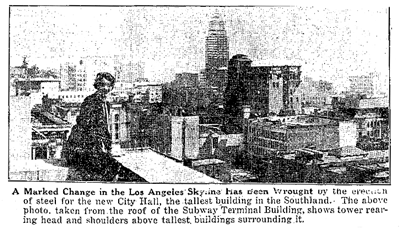
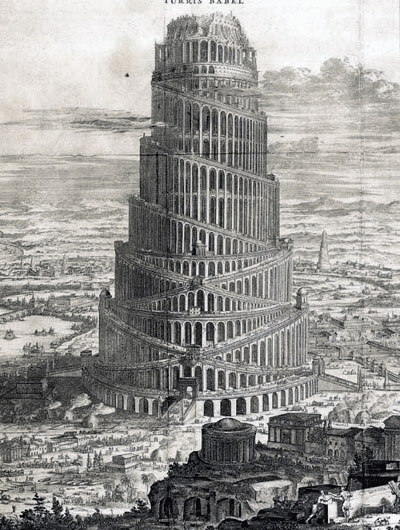

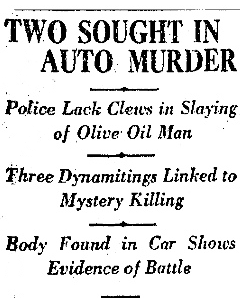
 On this Spring day in 1927, investigating officers were pavement-pounding in the Italian neighborhoods, attempting to scare up information about the April Fool’s Day discovery of one murdered Antonio (Tony) Ferraro. But there was no talking to be had, and the crime scene revealed nothing in the way of tell-tale fingerprints or any such evidence, and so Tony Ferraro remains another unsolved Los Angeles gangland slaying.
On this Spring day in 1927, investigating officers were pavement-pounding in the Italian neighborhoods, attempting to scare up information about the April Fool’s Day discovery of one murdered Antonio (Tony) Ferraro. But there was no talking to be had, and the crime scene revealed nothing in the way of tell-tale fingerprints or any such evidence, and so Tony Ferraro remains another unsolved Los Angeles gangland slaying.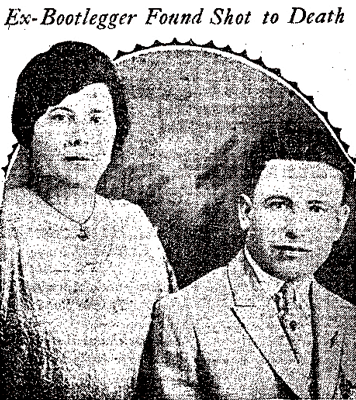 Robbery was not the motive, as Ferraro’s diamond ring, watch, money clip and olive oil were unmolested. Persons unknown entered Ferraro’s car, where he was beaten with a tire iron (his bruised hands indicating he put up a strong fight) and then shot in the head once with a .38 and twice with a .32. The body was then pulled from the front seat and lain across the olive oil in the back.
Robbery was not the motive, as Ferraro’s diamond ring, watch, money clip and olive oil were unmolested. Persons unknown entered Ferraro’s car, where he was beaten with a tire iron (his bruised hands indicating he put up a strong fight) and then shot in the head once with a .38 and twice with a .32. The body was then pulled from the front seat and lain across the olive oil in the back.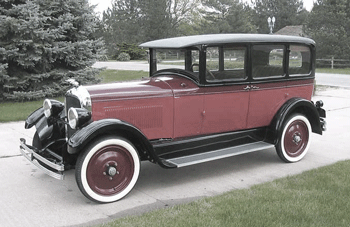 On April 5 the Times reported a rumor that Ferraro’s car had been seen the night of the 31st in
On April 5 the Times reported a rumor that Ferraro’s car had been seen the night of the 31st in 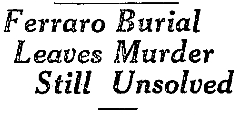




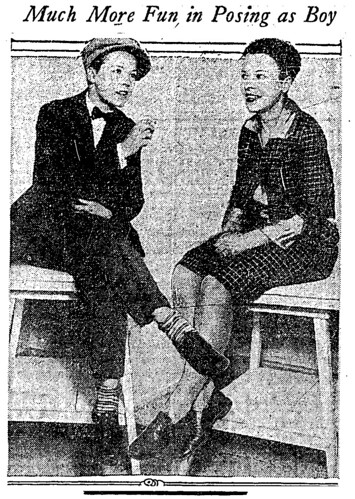


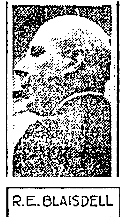 Fabrick, bank employees and customers were invited in thick Texas drawl to find themselves “a nice cozy spot on the floor” after which another bandit scooped $2,000 ($23,390 USD 2007) from the tills. They then lumbered out to a dust-covered touring car where a third bandit sat with a Winchester rifle across his knees. As the two egressed, one of the bandits held the door for an incoming customer and with true Texas courtesy drawled “It’s all right, lady. It’s all right. Walk right in.”
Fabrick, bank employees and customers were invited in thick Texas drawl to find themselves “a nice cozy spot on the floor” after which another bandit scooped $2,000 ($23,390 USD 2007) from the tills. They then lumbered out to a dust-covered touring car where a third bandit sat with a Winchester rifle across his knees. As the two egressed, one of the bandits held the door for an incoming customer and with true Texas courtesy drawled “It’s all right, lady. It’s all right. Walk right in.” 

